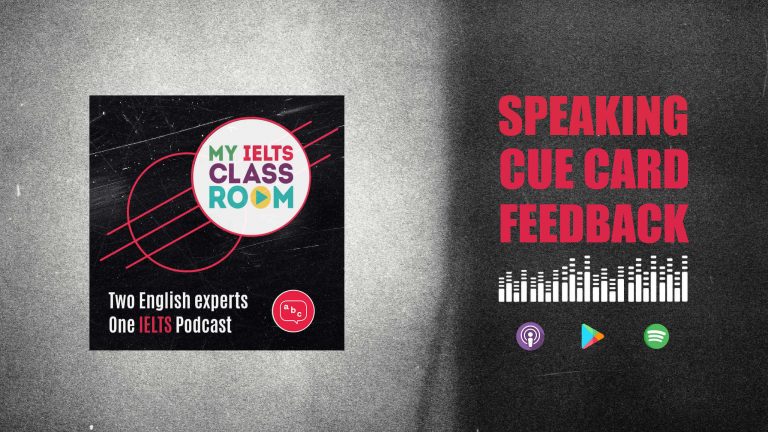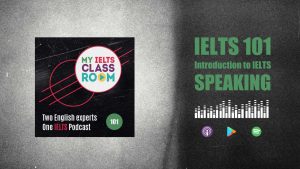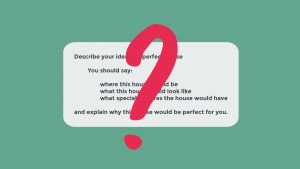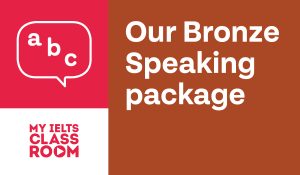
IELTS Cue Card Feedback
Hey! This week we have something different! Last week, I sent out a call on social media for our listeners to record themselves attempting three speaking part two questions. So today, Nick and I will be giving IELTS cue card feedback.
This is a great opportunity for you to learn how your speaking performance will be marked. Trust me – it is one thing to learn about the IELTS speaking band descriptors in theory, but it is quite another to see them applied in practice.
This is a Patron Only Episode: Click here to support the show and gain access to the audio or continue reading about why students are stuck at a 6.5 in the blog post below

https://www.patreon.com/myieltsclassroom
Below, you can find a summary of the episode, which includes all of the links to useful materials and the times of each part of the discussion (so you can go directly to the part you want to listen to)🚀
Subscribe to My IELTS Classroom podcast on Apple podcasts here
Subscribe to My IELTS Classroom on Google podcasts here
Podcast Summary: IELTS Cue Card Feedback!
00:00 – 01:55 Introduction (Shelly is going up a mountain for a yoga retreat 🧘).
01:55 – 05:18 IELTS Speaking Test Basics:
A quick quiz to review the basics of the IELTS speaking test. Do you know how long the speaking test lasts, what happens in each part of the test, or how the examiner will assess your performance? No? Well, listen to find out!
If you do not know basic information like this, then we strongly recommend that you go back and read or listen to our Introduction to IELTS speaking episode, where we will take you step by step through the most important details. It is important that you know what to expect on exam day so that you can prepare properly.]

05:18 – 09:53 IELTS Cue Card Basics
As today our focus is purely on Part 2, let’s review this part of the test in a bit more detail:
- How long do you have to prepare before you start to speak? 1 minute.
- Can you make notes? Yes, and we encourage this. Having short notes to help you during the two minutes can be a real help if you “run dry”.
- Can you start early if you want to? Yes, but we don’t recommend that you do this unless you are a native speaker. Use this time to think of ideas and high-level vocabulary.
- Do you have to talk about all of the bullets on the card? No, this is not necessary as there is no penalty for not covering a bullet. In my experience, students speak much more naturally when they just focus on the main topic of the cue card and speak freely.
- How will you know when your two minutes are up? The examiner will interrupt you (even if you are in the middle of a sentence!).
- Is it good if the examiner interrupts you? Yes! It means that you managed to keep speaking for 2 minutes, which is very good for your fluency and coherence score!
- What might the examiner ask you after you stop speaking? You may be asked a short question. We call this the “follow-up” question. It is always a yes/no question and, if you spoke for 2 minutes, your answer to this should be very short – just one or two sentences. If you didn’t manage to speak for 2 minutes, try to extend your answer for longer if you can to show the examiner that you are able to speak fluently.
09:54 – 19:59 What parts of the band descriptors does the examiner focus on in Speaking Part 2
Your examiner willI pay equal attention to every part of each test to make sure that the score they give accurately reflects your true level. However, I do think that each part of the test gives the examiner a chance to focus on different aspects of your performance. While Part 1, as we discussed a few weeks ago, is the place where the examiner may focus more on grammar (in particular use of tense) and lexis, I think part 2 is where they get to sit back and really pay attention to fluency. After all, you have to keep speaking for 2 minutes with minimal pauses, which is not easy for a lower-level student! Those who can’t keep going usually struggle for two reasons:
- their level of language is not high-enough
- they lack ideas for the particular cue card that they were given
If your problem is language, then you may simply need to spend more time focusing on basic lexis and grammar. However, the type of language you are asked to produce in this part of the test is pretty predictable. I think that there are nine main types of cue card (including describing a past event, describing a habit, and describing a hypothetical wish). That means you can target your study to make sure you have enough language structures to discuss each of these particular themes.

If your problem is ideas, then I would recommend that you always have two ideas for each cue card question. If you finish speaking about one, then just switch to the second. This is a great strategy and works for almost every card (and, remember, there is no penalty for this!). By switching, you will have a “clear sheet” and a whole new set of vocabulary to use, which should ensure that you never run out of things to say.

One of the best lectures I have ever seen was by Bene Brown, who spoke about what it means to trust…………. Another great lecture, was a TED talk about motivation…….
Finally, as the same 50 cue cards are used for 3 months at a time, it may be possible to find out the current topics. If you do find a reliable list, DO NOT MEMORISE ANSWERS! We promise you – it is so obvious when a student does this and you run the risk of the examiner discounting your part 2 response (which is not good!).
Pronunciation is another area that we focus on here.
Listening to a test-taker speak for 2 minutes without interruption makes it easy to see how good their intonation and sentence stress is. If you don’t know what these words mean, don’t worry! I discuss how you can practice this at home in this blog post.
20:00 : IELTS Cue Card Feedback
For the rest of the episode, Nick and I will give detailed feedback to all of the students who sent us recordings for these three cue cards. However, I just want to make it clear that although we will give rough scores to each student, no teacher can give a score based on only one part of the test. Your overall score will be based on your performance in all three parts of the test and if a student made some errors here, it may be possible to make up for these errors in Part 3 (or vice versa!). All we want to do here is offer a rough idea of the band level that these students may expect if they continue to perform at this level.
In this part of the episode, our IELTS cue card feedback will cover:
- Problems with past tenses when describing a past event (i.e. time travellers)
- High frequency of grammar errors
- Giving examples to support adjectives when describing a person
- Changing the focus of the cue card to match what you want to talk about
- Problems pronouncing single words
- Instances of high-level topic specific vocabulary
- Instances of high-level pronunciation
Would you like expert help to improve your IELTS speaking score?
We offer a 5-day intensive course for IELTS test-takers every month that covers all aspects of speaking, from how to approach each section to how to paraphrase well or address the most difficult questions in Part 3. Even better, with every course being run by an ex-examiner, you will be getting feedback is guaranteed to help you to improve your score. You can read more about the course here.

